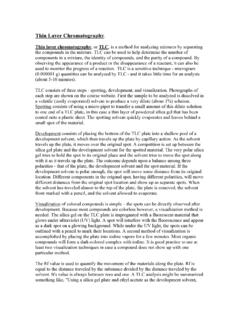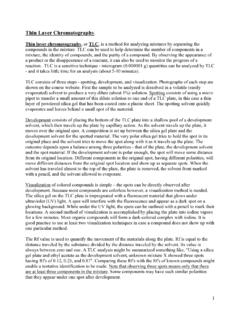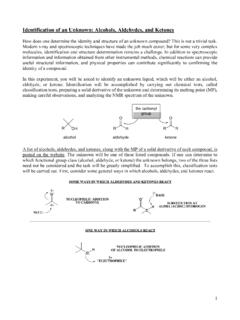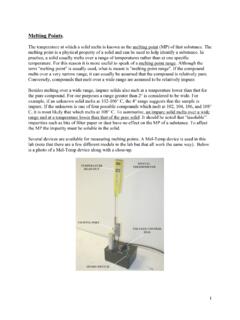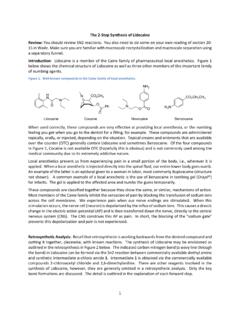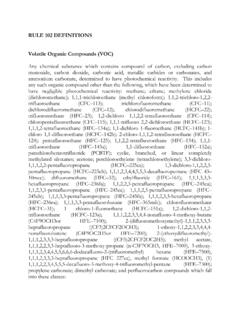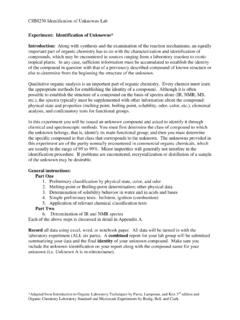Transcription of A Brief Discussion of Color - University of Massachusetts ...
1 A Brief Discussion on Color . Because several tests in the Alcohol, Aldehyde, and Ketone experiment involve Color changes or produce colored compounds, a modest understanding of Color will be helpful in the interpretation of the test results. What causes a compound to appear as being colored? The answer to this question lies in the way that electromagnetic energy interacts with matter. The portion of the electromagnetic spectrum that is of interest to this Discussion is the visible portion, or what we call light. This visible light includes all the colors that we perceive: violet, blue, green, yellow, orange, red, and the various combinations of these.
2 Although light can interact with matter in several different ways, this Discussion will limit the modes of interaction to absorption and reflection. (Some other modes of interaction include transmission, wherein light passes through an object, and scattering, wherein the incident light bounces off in many directions.). What may happen when light strikes an object? (1) All wavelengths of the light may be entirely reflected from the surface, which would result in what we perceive as the Color white. (2) All wavelengths may be entirely absorbed by the object, which would result in what we perceive as the Color black.
3 (3) The light may be completely transmitted through the object, with little interaction, resulting in what we call a colorless object. Glass is an example of this. (4) Some wavelengths can be reflected and others absorbed, resulting in the appearance of the different colors. The three components of the vision system are the object being viewed, the light, and the eye. When light strikes an object, a portion of the visible spectrum may be absorbed by the molecules comprising the object. Some portion that is not absorbed reflects off the object and strikes the eye, interacting with the molecules that make up the light sensors in the eye.
4 A signal is sent to the brain and Color is perceived. The question then leads to why are some portions of the spectrum absorbed by an object and others not absorbed ? This is determined by the structure of the molecules comprising the object (recall that structure determines properties). Most simple organic compounds, having few multiple bonds and few functional groups, do not absorb visible light, and thus appear as being colorless or white. More complex molecules, having several multiple bonds that are conjugated appear as being colored. For multiple bonds to be conjugated, they must be in an alternating double bond single bond double bond, etc arrangement.
5 Conjugated Not Conjugated Why does such conjugation allow absorption of visible light? When ultraviolet or visible light (UV-Vis) is absorbed by a molecule, the energy goes into increasing the energy levels of valence, or outer shell electrons. In other words when light is absorbed by the molecule, these electrons, which normally reside in the ground state, are pushed up to higher energy levels or to an excited state. If the energy level of the excited state is a lot higher than that of the ground state, a large amount of light energy is required to push the electrons up to the higher level, and a 1.
6 Correspondingly higher energy of light is needed to do this. If the excited state is closer in energy to the ground state, a correspondingly lower energy of light is needed. For molecules having conjugated systems of electrons, the ground states and excited states of the electrons are closer in energy than for nonconjugated systems. This means that lower energy light is needed to excite electrons in conjugated systems, which means that lower energy light is absorbed by conjugated systems. The degree of conjugation determines the actual energy difference between the ground and excited states. The more highly conjugated the system the lower the energy difference and the lower the required energy of light needed to excite the electrons.
7 In other words molecules having more conjugated multiple bonds absorb lower energies of light than do molecules having fewer conjugated multiple bonds. How does this affect the actual Color of a compound ? The energy of the various colors in the visible spectrum is different depending upon the Color . Energy of visible light increases in the following order: red (low energy), orange yellow, green, blue, violet (high energy). A highly conjugated system then might absorb the lower energy portions of the light and reflect what is not absorbed. It is this reflected portion that the eye will perceive as the Color of that object.
8 A. less highly conjugated system will require the absorption of the higher energy part of the spectrum, allowing the lower energy parts to be reflected to the eye. Note that the Color that is reflected is the complementary Color of the Color that is absorbed. For example if the high energy violet portion of the spectrum is absorbed, its complementary Color of yellow is what is observed. If the lower energy blue or green colors are absorbed, the colors orange or red would be observed. To illustrate this, consider the structure of a few molecules. Retinol, or vitamin A, has five conjugated double bonds and absorbs the violet part of the spectrum, thus appearing as yellow.
9 The more highly conjugated -carotene and lycopene, each having eleven conjugated double bonds absorb in the lower energy blue and green portions of the spectrum and appear as orange and red. The 1,3,5-heptatriene, having only three conjugated double bonds does not absorb in the visible portion of the spectrum and thus appears as being colorless. Its electrons can however be excited to a higher energy state by the absorption of the much higher energy ultraviolet light. 2. OH. 1,3,5-Heptatriene Retinol (vitamin A). (3 conjugated C=C bonds) (5 conjugated C=C bonds). (colorless) yellow Color ). -Carotene (11 conjugated C=C bonds).
10 (orange Color ). Lycopene (11 conjugated C=C bonds). (red Color ). In summary, more highly conjugated pi systems (conjugated multiple bond systems) will appear as being more red or orange and less highly conjugated pi systems will appear as being yellow. How is this related to this experiment? Many of the tests in this experiment produce colored compounds or solutions. Understanding how the Color may indicate the degree of conjugation will help in gaining useful information. Consider the 2,4-dinitrophenylhydrazone test. A. precipitate indicates the presence of an aldehyde or ketone. The precipitate itself can be used as a derivative.
